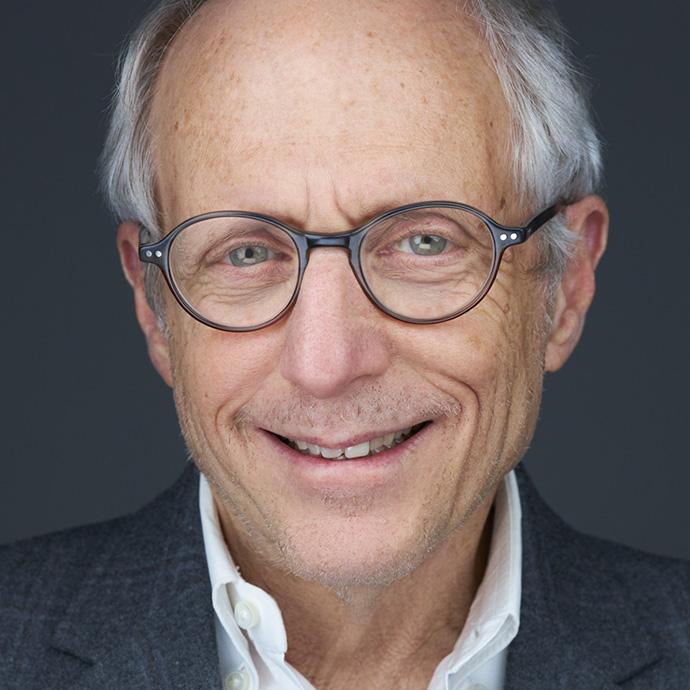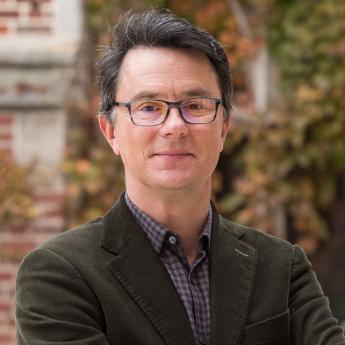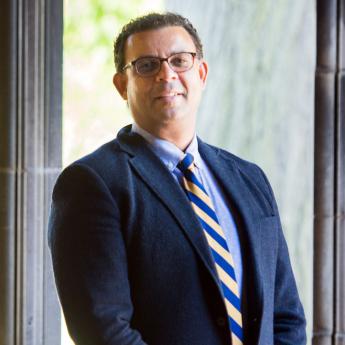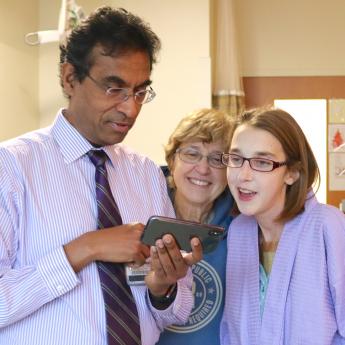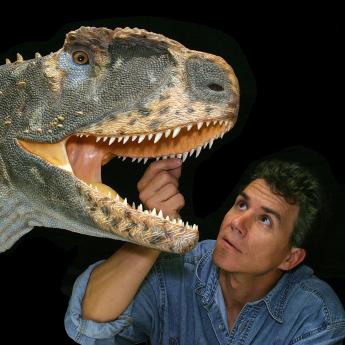Show Notes
For more than a century, scientists have been studying Alzheimer’s disease and developing theories about its underlying cause. The leading theory for decades has been that abnormal amyloid plaques in the brains of those who suffer from the disease are the central cause. But, according one renowned Alzheimer’s researcher, this myopic focus is not only flawed, but may be holding back our search for a cure.
Neurobiologist Karl Herrup argues that we need to go back to the drawing board, redefine the disease and understand the many factors that could cause it before we can race for a cure. A professor of neurobiology and an investigator in the Alzheimer’s Disease Research Center at the University of Pittsburgh School of Medicine, Herrup is the author of How Not to Study a Disease: The Story of Alzheimer’s.
Subscribe to Big Brains on Apple Podcasts and Spotify.
(Episode published March 21, 2024)
Subscribe to the Big Brains newsletter.
Please rate and review the Big Brains podcast.
Related:
- The Dark Tangle of Alzheimer’s—The New York Review
- Does new research really mean the ‘beginning of the end of Alzheimer’s’?—I News
- Allegations of fabricated research undermine key Alzheimer’s theory—NBC News
- Defining Alzheimer’s, and the climate costs of AI: Books in brief—Nature
Transcript:
Paul Rand: The University of Chicago Leadership and Society Initiative guides accomplished executive leaders in transitioning from their longstanding careers into purposeful encore chapters of leadership for society. The initiative is currently accepting candidates for its second cohort of fellows. Your next chapter matters for you and for society. Learn more about this unique fellowship experience at leadforsociety.uchicago.edu. Over the last few decades, we’ve made notable advances in cancer research and heart disease, but when it comes to Alzheimer’s disease, why have we made so little progress?
Tape: 6.7 million Americans are living with Alzheimer’s, and that is expected to nearly double by 2050.
Paul Rand: Alarmingly, one third of people over age 85 have Alzheimer’s disease, according to the National Institute on Aging.
Tape: Anyone who’s had experience with Alzheimer’s disease knows the agony of watching someone fade away, as it steals memory and, at the end, a person’s own identity.
Paul Rand: Despite us researching this disease since 1906, we still haven’t found a cure.
Karl Herrup: We know more about the brain, we know more about the biochemistry and genetics of Alzheimer’s disease than we ever have, but I feel that, by closing our minds and closing our research avenues down to a few narrow passageways, we’ve missed so many opportunities to really advance the field.
Paul Rand: That’s Karl Herrup, a professor of neurobiology and investigator in the Alzheimer’s Disease Research Center at the University of Pittsburgh School of Medicine, and he recently wrote a book called How Not to Study a Disease: The Story of Alzheimer’s.
Karl Herrup: You just don’t know where your next good idea is coming from. Very often, the best way to study Alzheimer’s disease is not to study Alzheimer’s disease. The light bulb was not invented by somebody trying to make a better candle. I think that applies in spades to the scientific enterprise.
Paul Rand: Herrup argues that the reason we’ve made so little progress with Alzheimer’s starts with the fact that we don’t have an accurate definition of the disease.
Karl Herrup: One of the issues I have with the field as a whole is that our definition of the disease has become so distorted. It’s almost a worthless moniker.
Paul Rand: If you can’t even define the thing you’re trying to study, how can you hope define a cure?
Karl Herrup: I’m speaking now as a basic researcher, where, if I am going to study a disease, I’m interested in, what are its biological underpinnings? What is it about the brain and its biology that drives the symptoms that I’m seeing? And in what ways can I intervene? If I can’t define what the disease is, my hands are tied as a biologist, and I feel that’s the situation we’re in today.
Paul Rand: The story of how we got here is fascinating, surprising, and more than mildly infuriating, but it holds important lessons for understanding how science can get led astray and how we can get back on track. But Herrup believes that we can really find better ways to treat Alzheimer’s.
Karl Herrup: I do believe we will be able to intervene and make that process less aggressive, less rapid, and less debilitating.
Paul Rand: Welcome to Big Brains, where we translate the biggest ideas and complex discoveries into digestible brain food. Big Brains, little bites from the University of Chicago Podcast Network. I’m your host, Paul Rand. On today’s episode, our struggle to find a cure for Alzheimer’s disease. Herrup’s book is called How Not to Study a Disease. But when exactly did we start going down the wrong path with Alzheimer’s? The answer, sadly, goes all the way back to the very beginning. I wonder, Karl, if we could start off, actually, as the son of a woman who suffered from Alzheimer’s, of a woman who suffered from Alzheimer’s and eventually passed from complications, many, many of our listeners, of course, are going to be familiar with this disease. In 1906, if we can talk about the patient that really started all of this work and the two scientists who started really the actual discovery of this.
Karl Herrup: So the patient who started our path to the state of Alzheimer’s disease right now was a farmer’s wife known as Auguste Deter. She became aggressive and almost unmanageable. So her husband brought her to a clinic, and one of the young physicians in the clinic was a brain scientist known as Alois Alzheimer. This was in Frankfurt, Germany, and he was quite interested, studied her, interviewed her. She subsequently died, because the supervisor of the clinic where she had been seen was aware that Alzheimer himself was interested in the structure of the brain, as it might underlie the function and malfunction in the case of Auguste. And so, arranged to have an autopsy performed and shipped samples of the brain to Alzheimer in his new role in Munich. It was then that he sectioned her brain and stained it with modern techniques, using silver to reveal the structure of neurons and other elements of the brain. And he discovered deposits that he said were abnormal.
Paul Rand: And we talked to [inaudible 00:05:52] about as plaques. What does it look like when there’s a plaque in the brain?
Karl Herrup: Well, normally, at this point, I would say, “If I may have the first slide, please,” but since we’re doing this on audio, the only way to describe them is they’re blobs. They’re many times bigger than a nerve cell, maybe 10 to 20 times as big, and they just don’t belong there. So since he had never seen these deposits before, he said that it must be these deposits that were driving the behavioral problems.
Paul Rand: Great. Problem solved, right?
Karl Herrup: The problem is, looking back now or even at the time, thinking about it logically, when two things occur together, it doesn’t necessarily mean that one causes the other. And even if one did cause the other, based on the correlation alone, you have to be very careful about assuming which way who causes what. In the case of Alzheimer, if I had been a reviewer of his paper, I would’ve said, “Well, Dr. Alzheimer, are you sure that the disease itself wasn’t what caused plaques?” So first, the disease, then the plaques. It’s caused a huge problem, because in confusing correlation with causality, the field has been trapped into this model of the disease.
Paul Rand: And your story of how it got to be accepted is also pretty ironic, isn’t it? Because this is not typically how peer review papers get accepted, put into science, and go from there. But this actually took a very different turn that gives the explanation.
Karl Herrup: That is correct. Alzheimer ultimately published his observations, and he published in what’s known as a case study, which is a very valuable form of scientific literature. It’s a description a physician gives, where he’s seen a patient or maybe a couple patients, and they have a very particular condition and he speculates as to how it might relate to the broader field of medicine. The irony was his boss, Emil Kraepelin, decided that he wanted to take it a step further. So Kraepelin was the author of a very influential textbook of neurological diseases, and he too was a big fan of the idea that the structure of the brain determined its function. And so, he too was a big fan of this idea that plaques therefore must be causing the dementia. But he took the rather audacious step of actually putting Auguste Deter’s case into his textbook, giving the condition a name, which he called Alzheimer’s disease.
Paul Rand: It’s nice he gave him credit for it.
Karl Herrup: Well, he gave him credit for it. Good guy. But we’re still trying to dig out from the hole that was created by that decision.
Paul Rand: That single decision to tie the definition of Alzheimer’s to the presence of these plaques would define how we study this disease and the search for a cure all the way to the present day. And what was originally just a hypothesis eventually solidified after a discovery in the 1980s and nineties.
Karl Herrup: A couple of clever biochemists, Glenner and Wong, were able to isolate the plaques and determine their amino acid sequence. In other words, what they were made of. And they discovered this small peptide that’s the A beta peptide, they discovered that the gene that encoded that peptide was on chromosome 21. And that got everybody excited, because chromosome 21, when it’s in three copies instead of the normal two, is the genetic condition known as Down syndrome. Sad though it may be, individuals with Down syndrome, as they age, undergo a premature onset of dementia and also build up plaques in their brain. And that led to geneticists, John Hardy and Higgins, to put forward what became known as the Amyloid Cascade Hypothesis.
Their idea was that, “Okay, we’ve got these plaques, sort of the pathological evidence of Alzheimer’s disease, and now, we have the biochemistry and the genetics all coming together. Therefore, we propose that this amyloid peptide begins to aggregate, and as it does so, it causes damage to the other cells of the brain, ultimately leading to the loss of neurons. And that’s where the dementia comes from.” That has been and it became and remains to this day the basis of Alzheimer’s disease. Again, as a hypothesis, that’s a perfectly rational point of view, but it’s become dogma.
Paul Rand: The challenge, as you write in your book, is that defense of this hypothesis became the mission in and of itself. Tell me what you mean by that, and is that unusual in science research? Or is it that this got jumped to the front of the line, when it wasn’t ready to be put in the front of the line?
Karl Herrup: What I try and bring out in my book is that, if you go back to those early days, this Amyloid Cascade Hypothesis was quite innovative and very compelling. It isn’t often that we have this beautiful congruence between biochemistry, genetics, and neuropathology, but as my mathematics friends say, “The best thing about a good hypothesis is you can take it out in the backyard and throw things at it to try and break it.” That’s what never happened with the Amyloid Cascade Hypothesis, that, instead what happened the certainty of its proponents became so rigid that counter arguments were just dismissed as silly and a waste of time.
Paul Rand: What if that original hypothesis from 1906 was misguided? What if these plaques don’t cause Alzheimer’s, rather the disease itself that leads to the plaques? Or even more controversial, what if these plaques are just a much smaller piece of a larger puzzle than we’ve realized?
Karl Herrup: So do we know more than we did in the 1990s? Of course we do. Could we have moved farther towards treatments and possibly cures for Alzheimer’s? I would say absolutely.
Paul Rand: Okay, and you make the point that it becomes very difficult to get funding for any research that doesn’t put the Amyloid Plaques Cascade Hypothesis front and center of the proposal.
Karl Herrup: Well, that is the result.
Paul Rand: The evidence for why these amyloid plaques may be the wrong place to look and where Herrup thinks we should be looking after the break. Have you ever wondered who you are, but didn’t know who to ask? Well then, join Professor Eric Oliver as he poses the nine most essential questions for knowing yourself to some of humanity’s wisest and most interesting people. Nine Questions with Eric Oliver, part of the University of Chicago Podcast Network. For much of the time we’ve studied Alzheimer’s, researchers’ theories have remained the same, amyloid plaques causes Alzheimer’s.
Karl Herrup: But I say, okay, let’s take that on. If that’s true, then if I have plaques, I must have dementia or I must be on my way to it. And it turns out that nothing could be further from the truth. If we take a cross section of individuals who are, say, 75 years old or 80 years old, and we look in their brains, either with modern PET imaging or after they die with neuropathology, we will find that about 30% of them have plaque burdens that a pathologist would say looks like Alzheimer’s disease.
Paul Rand: But they don’t have the symptoms?
Karl Herrup: They have no symptoms. They’re cognitively normal.
Paul Rand: Very interesting.
Karl Herrup: That seems to me to need a lot of explanation. So the counter argument becomes, “Okay, well, they just haven’t shown the symptoms yet, but they’re on their way.” And in fact, five years after having been diagnosed as having all these plaques in your brain, only half of the people with that plaque burden are going to be developing dementia.
Paul Rand: Only half? Wow. Okay. Fascinating. All right, so another bit of evidence that comes out is there were anti-amyloid vaccines that were being tested.
Karl Herrup: What we’re getting at here is the other side of the coin. So I said, if you have plaques in your brain and you don’t have dementia, that’s really a challenge to the Amyloid Cascade Hypothesis. But then, an equally strong challenge would be, okay, if I take plaques out of your brain, at least I should stop the progress of the disease.
Paul Rand: And that’s exactly what these anti-amyloid vaccines do, they train the immune system to target amyloid beta, which stops the development of amyloid plaques.
Karl Herrup: So at the time the book was published, it was basically true that over three dozen clinical trials that had successfully lowered the plaque burden of the brain had either not made people better or actually made them worse. So you vaccinate people, and lo and behold, the level of amyloid in their brain goes down. The problem, of course, is that people start getting really aggressive encephalopathies, meaning their brain starts swelling and nothing good.
Paul Rand: These anti-amyloid vaccines have gotten a lot of attention in recent years, but still nothing has successfully been approved as a treatment. But there’s another treatment you might’ve heard of, monoclonal antibodies.
Karl Herrup: The new monoclonal antibodies, which have been hyped as breakthroughs and triumphs, sorry, I’m not buying.
Paul Rand: So explain what the monoclonal antibodies are and what you’re not buying.
Karl Herrup: Okay. So normally, when you make a vaccine, you’re challenging your immune system to make an antibody. So you show the immune system what a virus looks like or what amyloid looks like. The immune system says, “Aha, I’ll remember that if I ever see it again.” And so, the next time it comes up, it mounts what’s called an immune response, makes antibodies, and gets rid of the virus or amyloid. The other way you can do this is you can take the antibodies made in some other creature, engineer them, so they’re tolerated by a human, and put them back into a human through a process called infusion. Because your body isn’t actually making the antibody itself, you’re just receiving antibody that was engineered in the lab. But it’s marginally safer, because it doesn’t induce the really dramatic, at least for the amyloid antibodies, it doesn’t induce the dramatic inflammation that came along with the first studies. So there are now three drugs that are either approved or very close to being approved. They all very dramatically reduced amyloid plaques within the brain.
Paul Rand: So there’s a lot of noise about those being great breakthroughs.
Karl Herrup: I refuse as a scientist to say they’re breakthroughs, and the noise comes from the following observation, compared to the placebo, people who were getting the antibody had a 33% less cognitive decline. All right, but here’s where the marketing comes back in. Because it’s marketed as an improvement, and the problem is it’s not an improvement, it’s just a less decline. So everybody in the trial, people getting the antibodies and people not getting the antibodies, the placebo, everybody got worse. The people on the antibody just got worse a little bit slower.
Paul Rand: Is that worth celebrating?
Karl Herrup: No.
Paul Rand: No? Okay, tell me why.
Karl Herrup: Well, because if you look at the actual difference, now, not the relative difference, between the placebo arm and the treatment arm, if you look at the absolute difference, the cognitive scale, it’s clinically undetectable. So that difference is unlikely to be recognizable by the patient, by their family, or by their physician.
Paul Rand: Inside your book, you spend a good amount of time talking about the role that you think that government funding organizations, not-for-profit organizations, pharma companies, and so forth played in driving this really myopic focus on the amyloid plaques. And I wonder if you think what lessons that should hold for us and what evolution from that you would love to see.
Karl Herrup: So in the early days of a new institute at the National Institutes of Health, known as the National Institute on Aging, its founders quickly realized that they were going to get the short end of the stick when it came to NIH dollars to actually fund their research. And so, they decided they had to do something to attract the funding dollars, and they realized that the idea of aging is not really scary. None of us want to age, but it’s not frightening, not like cancer. So they decided they needed a boogeyman, and they decided that, of all the diseases of aging, dementia was probably the most feared. But they decided that they needed something more sort of tangible. And what was argued by the founders of the NIA was that, well, if you look at the brains of anyone with dementia, you can find these plaques.
And so, therefore, all late onset dementia must be Alzheimer’s disease. So that seriously inflated the definition of the disease, because now, what we used to call senile dementia, meaning age appropriate loss of cognitive capacity, now had a disease name, people could get terrified. And it worked, because the NIA ended up with a substantial budget to work with. I think one of the strongest lessons is that, in a very odd way, science and money don’t mix very well, and I don’t mean that in the sense of research support. So science needs infrastructure, science needs people, science needs resources to advance. What science doesn’t need is lobbying.
What science doesn’t need is, I don’t know how to put this, but having the ends drive the means, because the pharmaceutical industry stands to make so much money, if they can have proprietary rights on a drug that will prevent or improve somebody’s Alzheimer’s disease, they drive the show. They have an outsized influence on the funding agencies, both public and private. That works to our detriment. It’s good for their bottom line or at least it is at the end of the quarter, but it doesn’t help science. Am I being a bit parochial here? Of course, I’m a basic scientist. I’ve got a dog in this fight, as they say, but being as objective as I can, I’m always struck by how the most revolutionary scientific discoveries come out of left field.
Paul Rand: Your book came out, what, three years ago at this point. Now, what was reaction, not only to your work, to your book, because you’re challenging convention? And how did the community, the research community, that Alzheimer’s community, first, take to what you were proposing?
Karl Herrup: That’s a great question, and I like that question. And I’ll tell you later a question that I don’t like, but I like this question.
Paul Rand: Okay.
Karl Herrup: For most people who are new to the field, which is heavily slanted towards the younger people in the field, the reaction has been one of gratitude. “Thank you so much. I thought I was crazy. What you’re saying makes a lot of sense.”
Paul Rand: And so, anybody listening to this, that has been affected by it or otherwise, my back really goes up on this, because of course, if you’ve had the experience with it and then, realize there’s been opportunity squandered, it becomes pretty easy to get frustrated by that. The inevitable question that you and everybody else in the field, especially now with, I think, as you’re talking about, “Well, don’t do this, do this,” and where either this is going to be relief to people that are listening to it or they’re going to be frustrated as all get out, because we all want the magic pill or the magic vaccine or whatever the case is.
Karl Herrup: Remember I told you there was a question that I hated?
Paul Rand: Yes.
Karl Herrup: Well, you’re getting very close to that question. Because the question that I hate the most is, “Okay, wise guy, if it’s not amyloid, what is it?”
Paul Rand: Of course.
Karl Herrup: The problem with that question is that I have to be honest and say, “I don’t know.” My thinking is evolving, even since I’ve written the book, and honestly, I’m beginning to think of a dementia like Alzheimer’s as a multifactorial disease. And bear with me here, because it’s a little bit complicated, but I think, to me, as a scientist, it’s a satisfying explanation. I list a number of things we should talk about. There’s a reasonable biochemistry, reasonable cell biology, reasonable genetics, that suggests that an out of control inflammatory process is at work here. So inflammation is a big one. There’s good epidemiology that says, if you’ve been on anti-inflammatories, unfortunately, at very high doses, your lifetime risk of Alzheimer’s and dementia goes down.
Paul Rand: Goes down?
Karl Herrup: Yes. And I think, as I say in my book, do not go to the drugstore and buy ibuprofen and start popping pills, because you will rot out the internal lining of your stomach long before you do anything for your dementia.
Paul Rand: Okay. All right. Good to put that catch in there.
Karl Herrup: Fat management is another. And my favorite right now is the role of the myelin around neurons. Because it insulates, it actually saves the neuron an enormous amount of energy. Why it degenerates, as we get older, we don’t know, but there is no question that, as we age, we start to lose myelin and we start to lose it sort of in midlife, in our forties. And we lose it in precisely the areas that are most affected in the course of Alzheimer’s disease. Each of these, and let’s include amyloid in the list, that each of these contributes to an altered brain chemistry, and it’s actually that sum that is what we recognize as Alzheimer’s disease. And so, attacking each of them is valuable, and ultimately, we need to attack all of them.
It’s increasingly apparent that it is the non-pharmacological changes that have proven to be the most effective tools in the fight against Alzheimer’s. And they’re uninteresting. They’re not sexy, and there’s no intellectual property left. So the pharmaceutical companies are largely uninterested. But aggressively controlling blood pressure, I mentioned that in the book, keeping your blood pressure down. Exercise helps, mental exercise and physical. Recent study looking at just a daily dose of a multivitamin. Basically, things that are helpful in keeping your health up in the presence of an aging body, heart health, brain health, dietary health, that these are the most effective tools we have to fight Alzheimer’s disease. And it makes total sense, because as I described in the book, the biggest single risk factor for Alzheimer’s is age. I do think that this process of aging is what increases your risk of Alzheimer’s and a senile dementia.
But you see, because I don’t want your listeners to come away or you to come away with the idea that Alzheimer’s is just accelerated aging, I do think that there’s a disease process that something happens. There is a moment, a threshold, where the chemistry of our brains and our bodies kicks into a degenerative pattern. It’s as important to understand that biology as it is to understand the biology of normal aging, so we can help people in both ways. And just for your listeners and for you, I just urge patients, and I think that’s really important. Alzheimer’s, dementia, aging, these are extremely complicated problems, and their solution is not going to be quick and it’s not going to be simple. It’s going to be incremental. But despite everything I’ve said, I remain extremely optimistic that we’re going to crack this problem.
Matt Hodapp: Brains is a production of the University of Chicago Podcast Network. We are sponsored by the Graham School. Are you a lifelong learner with an insatiable curiosity? Access more than 50 open enrollment courses every quarter. Learn more at graham.uchicago.edu/bigbrains. If you like what you heard on our podcast, please leave us a rating and review. The show is hosted by Paul M. Rand and produced by Lea Ceasrine and me, Matt Hodapp. Thanks for listening.
Episode List
Leading Presidential Scholar Analyzes Trump Impeachment with William Howell (Ep. 32)
Presidential scholar William Howell examines historic decision and its impact on power in the White House.
The Politics of Archaeology In Iraq With Christopher Woods (Ep. 31)
The director of the Oriental Institute at the University of Chicago explains how archaeological investment becomes a form of diplomacy.
Supreme Court Justice Ruth Bader Ginsburg On Polarization, Discrimination and Her Favorite Dissent (Ep. 30)
For this episode, please enjoy a special conversation with Supreme Court Justice Ruth Bader Ginsburg discussing her history and role on the Supreme Court.
Why Your Social Life is a Matter of Life and Death with Linda Waite (Ep. 29)
A distinguished University of Chicago professor’s groundbreaking research provides insights into the overlooked importance of social health.
How John List Revolutionized Economics by Studying People in the Real World (Ep. 28)
Behind the scenes of policymakers reshaping our society, there are researchers supplying them with answers to our most pressing questions. University of Chicago economist John List is one of those people.
Trump and the Changing Power of the Presidency with William Howell (Ep. 27)
One of the leading scholars on the American presidency gives us insight into the Trump era, the history of impeachment, and the power of the office.
How the Loss of Community Threatens Society with Raghuram Rajan (Ep. 26)
One of the world’s leading economists explains why our communities could hold the answer to many of society’s problems.
The Science of Conspiracy Theories and Political Polarization with Eric Oliver (Ep. 25)
A UChicago political science professor explains how the same force that drives conspiracy theories is intensifying political polarization in our country.
A Modern Medical Miracle with Drs. Valluvan Jeevanandam and Talia Baker (Ep. 24)
A unbelievable coincidence pushes two transplant doctors to attempt a medical feat no one has ever attempted.
An Archaeological Riddle In the Sahara with Paul Sereno (Ep. 23)
A UChicago paleontologist puts aside dinosaur hunting when he discovers a never-before-seen ancient society.
